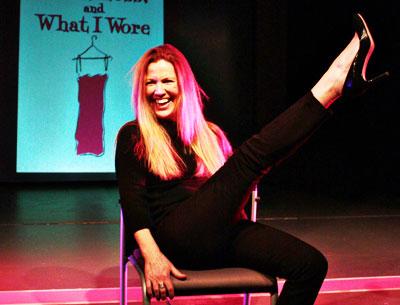Opinion: ‘Love, Loss,’ And the Universal

While you don’t have to be a woman to enjoy “Love, Loss, and What I Wore,” it certainly helps. The smattering of men in the audience at the Southampton Cultural Center on Thursday night seemed to be enjoying themselves at this frothy pink cocktail of a production, but it was the women who laughed the most and the longest.
Last Thursday’s presentation was singular for the appearance of Ilene Beckerman, the author of the book on which the play is based, as the character Gingy, the author’s nickname. She had never appeared as herself in any production of the play, which was written by Nora and Delia Ephron using two of Ms. Beckerman’s books and the Ephrons’ friends’ own experiences. But Michael Disher, who directed the play, worked his magic to transform another non-professional into a credible and charming performer in an evening of diverting monologues and group reflections on topics such as mothers, miniskirts, marriage, boots, sexuality, and even Madonna as a style muse, at least on Halloween.
At 77, Ms. Beckerman was adorable as herself, vibrant and enchanting and full of the spunk and insight that emanated, too, from her writing as channeled by the Ephrons.
She was joined on stage for this presentation by Barbara Jo Howard, Deborah Marshall, Catherine Maloney, and Bethany Dellapolla. The cast revolves to include at various times the four actresses who performed that night as well as Brooke Alexander, Katie Lee, Gretta Monahan, Susan Cincotta, Paula Brannon, Susan Wojcik, and Edna Perez Winston.
The staging, which consists of the five women sitting on stage with scripts on music stands as in a reading, is comfortable on one hand and challenging on the other. How to keep the audience interested with such a static environment?
The answer is smart and elegant: Incorporate Ms. Beckerman’s original drawings from the book as projections so the audience can see her depictions of herself as well as photographic illustrations and collages of some of the other items of clothing discussed in the play. The latter were conceived by Ms. Dellapolla and are exclusive to this production.
Add in some movement and a few brief dance routines along with some acting between the readers in between the monologues, and what could have been a long slog becomes an engaging event. The comedy inherent in the material helps too, especially after discussing heavier topics such as mothers dying too young, early heartbreak, and divorce.
The cast was dressed all in black, with only Ms. Beckerman’s sparkly head wrap standing out in the darkness. Although it could be viewed by some to be a cop out, the neutrality of the cast, in contrast with the clothes described, allowed for a more fluid audience experience. These are universal sartorial moments — prom dress, important date dress, wedding gown — so women are then free to imagine using their own choices and wardrobe as reference. It makes the experience more appealingly universal.
The dialogue is snappy; the references all are accessible. Despite its original source, it definitely has the Ephron stamp — a kind of everywoman lowest common denominator approach, provided the audience is smart, stylish, college-educated, and not from a flyover state. I might even add “of a certain age,” since the stories included all seem to be from a time and place a few decades removed, whether from Ms. Beckerman or from the women the Ephrons recruited, except girls and women tend to be curious about the generations who preceded them and the collective experience of the feminine is rife with traditions and rites of passage that don’t change all that much from decade to decade. The horror of trying clothes on in a dressing room, getting a bra that fits, being dumped after sex for the first time, the joy of wearing the all-forgiving non-color black; these are all things to which any woman can easily relate.
All of those performing last Thursday were well-rehearsed and certainly doing less reading of the text than acting it out. It is a perfect play for a minimal and shallow stage such as the one at the cultural center. Mr. Disher has said previously that he much prefers full productions over stripped-down readings, but this production really suited the space and his embellishments. The lighting and sound design by Daniel Schappert gave what could have been a stark and austere environment the kind of visual pop that made the actors and their production sparkle.
“Love, Loss, and What I Wore” is being performed Thursdays at 7:30 p.m., Fridays and Saturdays at 8 p.m., and Sundays at 2:30 p.m. through Jan. 27. Tickets are $22 and $15 for students under 21 with ID.
